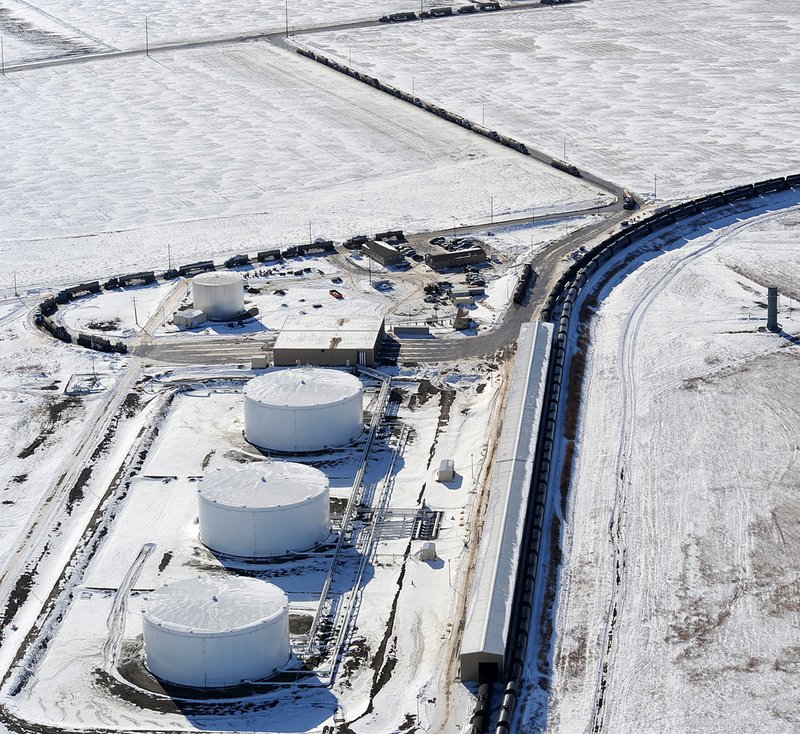BILLINGS, Mont. – Energy companies behind the oil boom on the Northern Plains are turning to the locomotive to move their crude to refineries across the United States, as plans for new pipelines stall and existing lines can’t keep up with demand.
Delivering oil thousands of miles by rail from the heartland to refineries on the East, West and Gulf coasts costs more, but it can mean increased profits — up to $10 or more a barrel — because of higher oil prices on the coasts. That works out to about $700,000 per train.
The parade of mile-long trains carrying hazardous material out of North Dakota and Montana and across the country has experts and federal regulators concerned. Rail transport is less safe than pipelines, they say, and the proliferation of oil trains raises the risk of a major derailment and spill.
Since 2009, the number of train cars carrying crude hauled by major railroads has jumped from about 10,000 a year to a projected 200,000 in 2012. Much of that has been in the Northern Plains’ Bakken crude patch, but companies say oil trains are rolling or will be soon from Texas, Colorado and western Canada.
“This is all occurring very rapidly, and history teaches that when those things happen, unfortunately, the next thing that is going to occur would be some sort of disaster,” said Jim Hall, a transportation consultant and former chairman of the National Transportation Safety Board.
Rail companies say the industry places a priority on safety and has invested heavily in track upgrades, provided emergency training and taken other measures to guard against accidents. There have been no major oil train derailments from the Bakken, according to federal regulators.
Union Pacific Railroad CEO Jack Koraleski says hauling oil out of places such as North Dakota will be a long-term business for railroads because trains are faster than pipelines, reliable and offer a variety of destinations.
“The railroads are looking at this as a unique opportunity, a game-changing opportunity for their business,” said Jeffery Elliot, a rail expert with the New York-based consulting firm Oliver Wyman.
BNSF Railway Co., the prime player in the Bakken, has bolstered its oil train capacity to 1 million barrels a day and expects that figure to increase further. To accommodate the growth, in part, the railroad is sinking $197 million into track upgrades and other improvements in Montana and North Dakota.
BNSF is also increasing train sizes, from 100 oil cars per train to as many as 118.
Larger trains are harder to control, and that increases the chances of something going wrong, safety experts say. State and local emergency officials worry about a derailment in a population center or an environmentally sensitive area such as a river crossing.
Rail accidents occur 34 times more frequently than pipeline ones for every ton of crude or other hazardous material shipped comparable distances, according to a recent study by the Manhattan Institute, a conservative think tank. The Association of American Railroads contends the study was flawed but acknowledges the likelihood of a rail accident is double or triple the chance of a pipeline problem.
The environmental fears carry an ironic twist: Oil trains are gaining popularity in part because of a shortage of pipeline capacity — a problem that has been worsened by environmental opposition to projects such as TransCanada’s stalled Keystone XL pipeline. That project would carry Bakken and Canadian crude to the Gulf of Mexico.
Wayde Schafer, a North Dakota spokesman for the Sierra Club, described rail as “the greater of two evils” because trains pass through cities, over waterways and through wetlands that pipelines can be built to avoid.
“It’s an accident waiting to happen. It’s going to be a mess and we don’t know where that mess is going to be,” Schafer said.
Send questions/comments to the editors.



Success. Please wait for the page to reload. If the page does not reload within 5 seconds, please refresh the page.
Enter your email and password to access comments.
Hi, to comment on stories you must . This profile is in addition to your subscription and website login.
Already have a commenting profile? .
Invalid username/password.
Please check your email to confirm and complete your registration.
Only subscribers are eligible to post comments. Please subscribe or login first for digital access. Here’s why.
Use the form below to reset your password. When you've submitted your account email, we will send an email with a reset code.